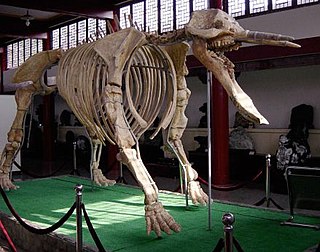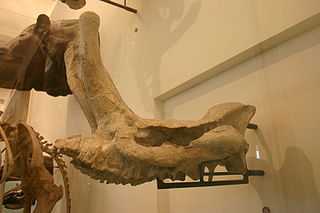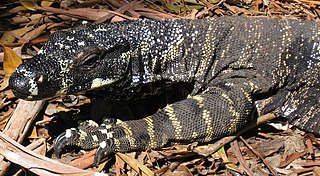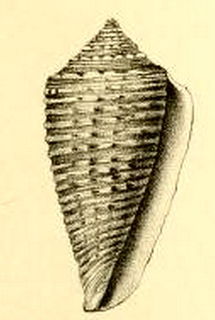
Platybelodon was a genus of large herbivorous mammals related to the elephant. It lived during the middle Miocene Epoch in Africa, Asia and the Caucasus.

Embolotherium is an extinct genus of brontothere that lived in Mongolia during the late Eocene epoch. It is most easily recognized by a large bony protuberance emanating from the anterior (front) of the skull. This resembles a battering ram, hence the name Embolotherium. The animal is known from about 12 skulls, several jaws, and a variety of other skeletal elements from the Ulan Gochu formation of Inner Mongolia and the Irgilin Dzo of Outer Mongolia.

Pinacosaurus is a genus of medium-sized ankylosaur dinosaurs that lived from the late Santonian to the late Campanian stages of the late Cretaceous Period, in Mongolia and China.

Varanoidea is a superfamily of lizards, including the well-known family Varanidae. Also included in the Varanoidea are the Lanthanotidae, and the extinct Palaeovaranidae.

Asiatosuchus is an extinct genus of crocodyloid crocodilians that lived in Eurasia during the Paleogene. Many Paleogene crocodilians from Europe and Asia have been attributed to Asiatosuchus since the genus was named in 1940. These species have a generalized crocodilian morphology typified by flat, triangular skulls. The feature that traditionally united these species under the genus Asiatosuchus is a broad connection or symphysis between the two halves of the lower jaw. Recent studies of the evolutionary relationships of early crocodilians along with closer examinations of the morphology of fossil specimens suggest that only the first named species of Asiatosuchus, A. grangeri from the Eocene of Mongolia, belongs in the genus. Most species are now regarded as nomina dubia or "dubious names", meaning that their type specimens lack the unique anatomical features necessary to justify their classification as distinct species. Other species such as "A." germanicus and "A." depressifrons are still considered valid species, but they do not form an evolutionary grouping with A. grangeri that would warrant them being placed together in the genus Asiatosuchus.

Conus grangeri, common name Granger's cone, is a species of sea snail, a marine gastropod mollusk in the family Conidae, the cone snails and their allies.
Telmasaurus is an extinct genus of varanoid lizard from the Late Cretaceous of Mongolia. Fossils have been found from the Djadokha and Barun Goyot Formations that date between the early and middle Campanian stage from approximately 80 to 75 million years ago. The type species Telmasaurus grangeri was named in 1943.
Nanohammus is a genus of longhorn beetles of the subfamily Lamiinae, containing the following species:

Ptolemaia is a genus of extinct Afrotherian mammals from the Oligocene of East Africa. The genus and type species, P. lyonsi, was described by Henry Fairfield Osborn in 1908 from the Jebel Qatrani Formation of Egypts' Fayum Depression. The genus name alludes to the Ptolemaic dynasty of Ancient Greece which ruled over the Egyptian region where Ptolemaia was discovered, while the specific epithet lyonsi honors H. G. Lyons, then director of the Egyptian Geological Survey. A second species, P. grangeri, was described in 1987, and named after the early 20th century paleontologist Walter W. Granger. Fossils of P. grangeri are also known from Kenya.

Amebelodontidae is an extinct family of large herbivorous mammals that were closely related to elephants. They were assigned to Gomphotheriidae in the past, but recent authors consider them a distinct family.
Nanohammus aberrans is a species of beetle in the family Cerambycidae. It was described by Charles Joseph Gahan in 1894.
Nanohammus alboplagiatus is a species of beetle in the family Cerambycidae. It was described by Stephan von Breuning in 1944. It is known from Malaysia and Borneo.
Nanohammus annulicornis is a species of beetle in the family Cerambycidae. It was described by Maurice Pic in 1934.
Nanohammus itzingeri is a species of beetle in the family Cerambycidae. It was described by Stephan von Breuning in 1935.
Nanohammus myrrhatus is a species of beetle in the family Cerambycidae. It was described by Francis Polkinghorne Pascoe in 1878.
Nanohammus rondoni is a species of beetle in the family Cerambycidae. It was described by Stephan von Breuning in 1963.
Nanohammus rufescens is a species of beetle in the family Cerambycidae. It was described by Henry Walter Bates in 1884. It is known from Japan.
Nanohammus sinicus is a species of beetle in the family Cerambycidae. It was described by Maurice Pic in 1925. It is known from China.
Nanohammus subfasciatus is a species of beetle in the family Cerambycidae. It was described by Masaki Matsushita in 1941. It is known from Taiwan and Japan.
Nanohammus taiyal is a species of beetle in the family Cerambycidae. It was described by Gressitt in 1951.









